FNSACC408 - Certificate IV Accounting and Bookkeeping Assessment
VerifiedAdded on 2023/01/12
|41
|9693
|57
Homework Assignment
AI Summary
This document is a comprehensive student assessment booklet for the FNSACC408 Work effectively in the accounting and bookkeeping industry unit, part of the FNS40217 Certificate IV in Accounting and Bookkeeping. The booklet outlines four assessment tasks designed to evaluate the student's understanding of the subject. Assessment Task 1 consists of written questions, requiring the student to answer questions correctly. Assessment Task 2 focuses on customer feedback, requiring the student to plan a client questionnaire and respond to the feedback received. Assessment Task 3 involves a business start-up project where the student must make recommendations based on a case study scenario. Assessment Task 4 is a professional development project, where the student identifies professional development opportunities for bookkeepers and participates in one. The booklet includes assessment instructions, cover sheets, checklists, and a student assessment agreement, providing all the necessary information for completing the assessments successfully. The assessment plan specifies the requirements for each task, including the need to complete all tasks satisfactorily to be deemed competent.
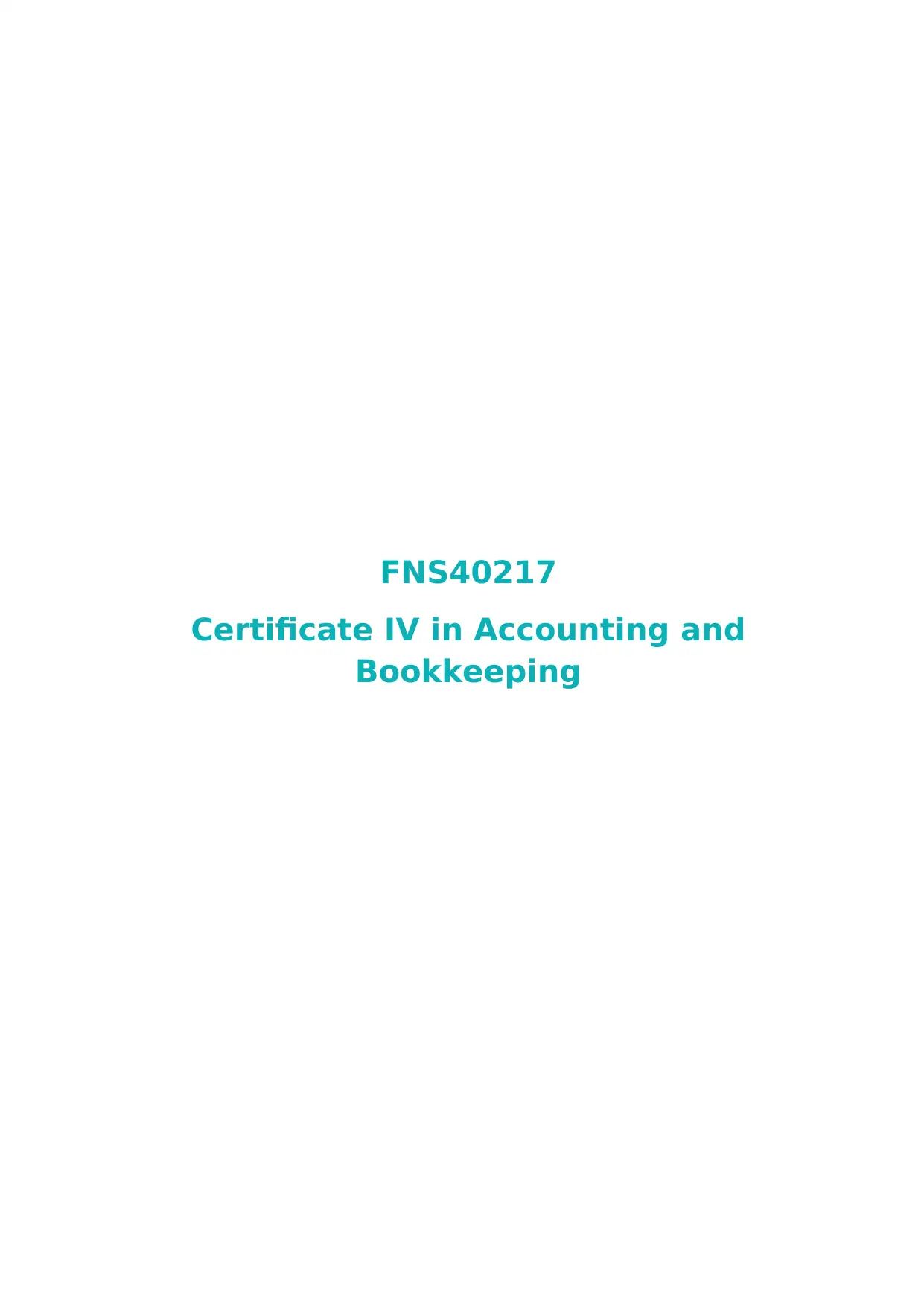
Student Assessment Booklet
FNSACC408 Work effectively in the accounting and
bookkeeping industry
FNS40217
Certificate IV in Accounting and
Bookkeeping
FNSACC408 Work effectively in the accounting and
bookkeeping industry
FNS40217
Certificate IV in Accounting and
Bookkeeping
Paraphrase This Document
Need a fresh take? Get an instant paraphrase of this document with our AI Paraphraser
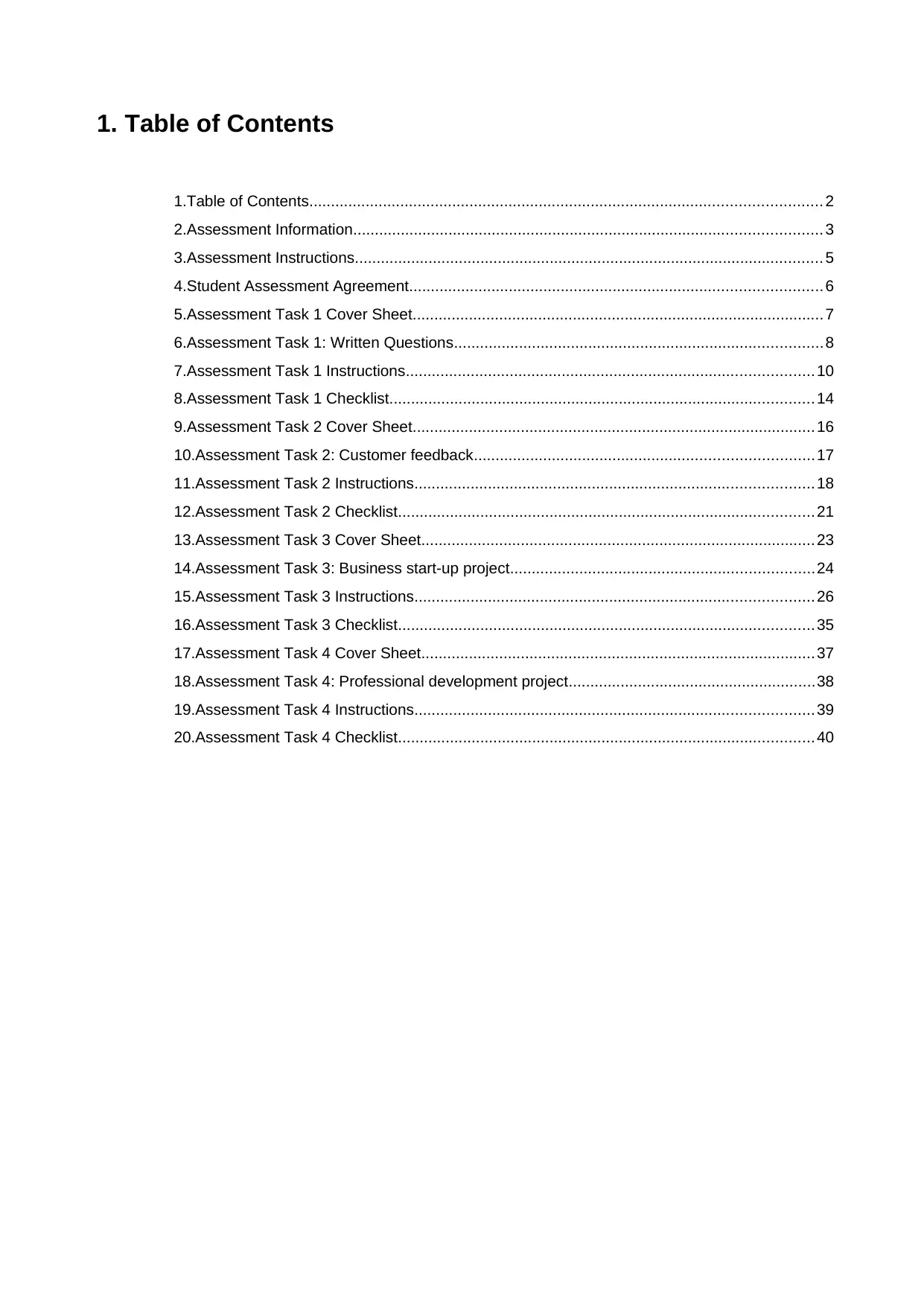
1. Table of Contents
1.Table of Contents...................................................................................................................... 2
2.Assessment Information............................................................................................................ 3
3.Assessment Instructions............................................................................................................ 5
4.Student Assessment Agreement............................................................................................... 6
5.Assessment Task 1 Cover Sheet............................................................................................... 7
6.Assessment Task 1: Written Questions.....................................................................................8
7.Assessment Task 1 Instructions.............................................................................................. 10
8.Assessment Task 1 Checklist.................................................................................................. 14
9.Assessment Task 2 Cover Sheet............................................................................................. 16
10.Assessment Task 2: Customer feedback..............................................................................17
11.Assessment Task 2 Instructions............................................................................................ 18
12.Assessment Task 2 Checklist................................................................................................ 21
13.Assessment Task 3 Cover Sheet........................................................................................... 23
14.Assessment Task 3: Business start-up project......................................................................24
15.Assessment Task 3 Instructions............................................................................................ 26
16.Assessment Task 3 Checklist................................................................................................ 35
17.Assessment Task 4 Cover Sheet........................................................................................... 37
18.Assessment Task 4: Professional development project.........................................................38
19.Assessment Task 4 Instructions............................................................................................ 39
20.Assessment Task 4 Checklist................................................................................................ 40
1.Table of Contents...................................................................................................................... 2
2.Assessment Information............................................................................................................ 3
3.Assessment Instructions............................................................................................................ 5
4.Student Assessment Agreement............................................................................................... 6
5.Assessment Task 1 Cover Sheet............................................................................................... 7
6.Assessment Task 1: Written Questions.....................................................................................8
7.Assessment Task 1 Instructions.............................................................................................. 10
8.Assessment Task 1 Checklist.................................................................................................. 14
9.Assessment Task 2 Cover Sheet............................................................................................. 16
10.Assessment Task 2: Customer feedback..............................................................................17
11.Assessment Task 2 Instructions............................................................................................ 18
12.Assessment Task 2 Checklist................................................................................................ 21
13.Assessment Task 3 Cover Sheet........................................................................................... 23
14.Assessment Task 3: Business start-up project......................................................................24
15.Assessment Task 3 Instructions............................................................................................ 26
16.Assessment Task 3 Checklist................................................................................................ 35
17.Assessment Task 4 Cover Sheet........................................................................................... 37
18.Assessment Task 4: Professional development project.........................................................38
19.Assessment Task 4 Instructions............................................................................................ 39
20.Assessment Task 4 Checklist................................................................................................ 40
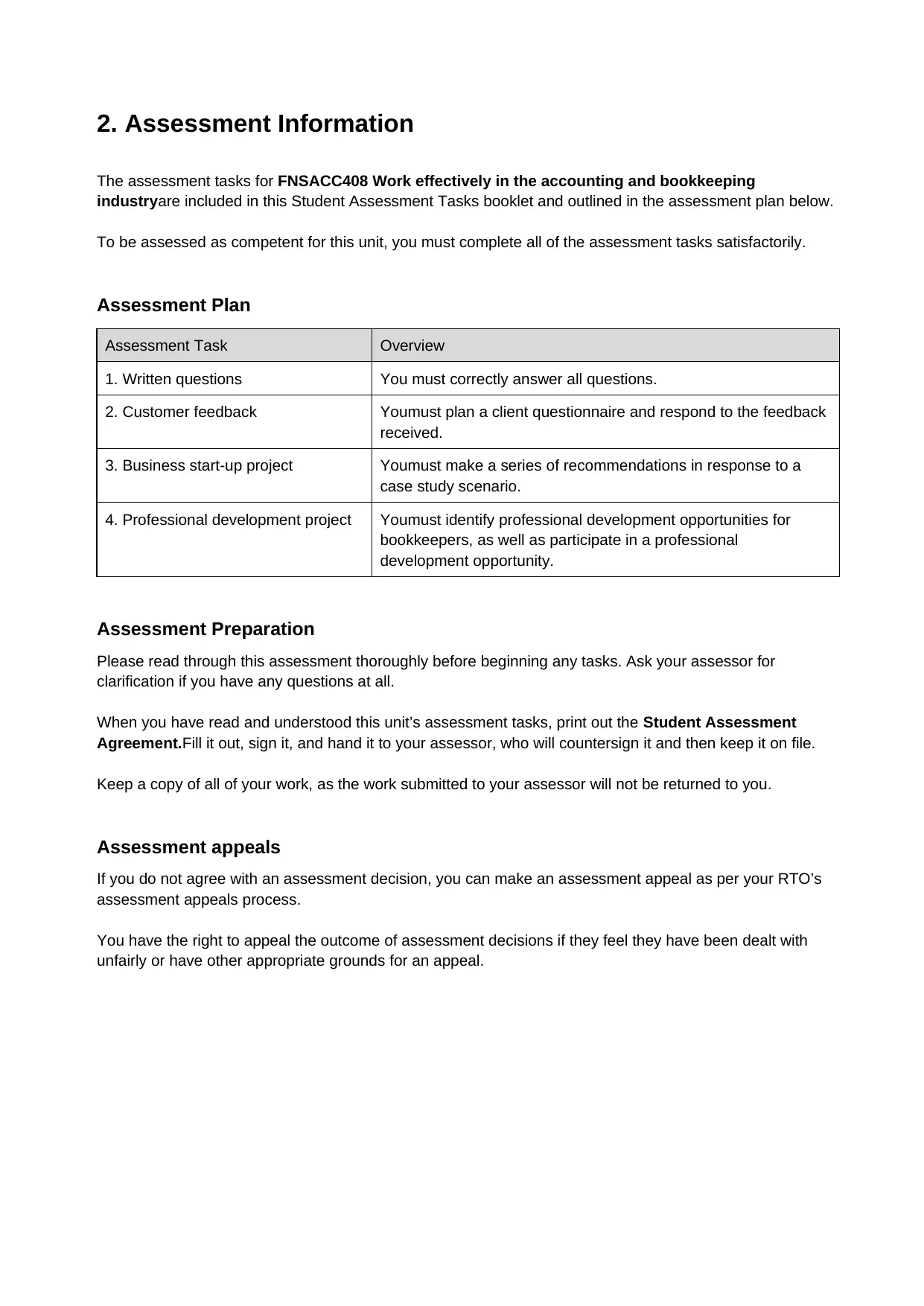
2. Assessment Information
The assessment tasks for FNSACC408 Work effectively in the accounting and bookkeeping
industryare included in this Student Assessment Tasks booklet and outlined in the assessment plan below.
To be assessed as competent for this unit, you must complete all of the assessment tasks satisfactorily.
Assessment Plan
Assessment Task Overview
1. Written questions You must correctly answer all questions.
2. Customer feedback Youmust plan a client questionnaire and respond to the feedback
received.
3. Business start-up project Youmust make a series of recommendations in response to a
case study scenario.
4. Professional development project Youmust identify professional development opportunities for
bookkeepers, as well as participate in a professional
development opportunity.
Assessment Preparation
Please read through this assessment thoroughly before beginning any tasks. Ask your assessor for
clarification if you have any questions at all.
When you have read and understood this unit’s assessment tasks, print out the Student Assessment
Agreement.Fill it out, sign it, and hand it to your assessor, who will countersign it and then keep it on file.
Keep a copy of all of your work, as the work submitted to your assessor will not be returned to you.
Assessment appeals
If you do not agree with an assessment decision, you can make an assessment appeal as per your RTO’s
assessment appeals process.
You have the right to appeal the outcome of assessment decisions if they feel they have been dealt with
unfairly or have other appropriate grounds for an appeal.
The assessment tasks for FNSACC408 Work effectively in the accounting and bookkeeping
industryare included in this Student Assessment Tasks booklet and outlined in the assessment plan below.
To be assessed as competent for this unit, you must complete all of the assessment tasks satisfactorily.
Assessment Plan
Assessment Task Overview
1. Written questions You must correctly answer all questions.
2. Customer feedback Youmust plan a client questionnaire and respond to the feedback
received.
3. Business start-up project Youmust make a series of recommendations in response to a
case study scenario.
4. Professional development project Youmust identify professional development opportunities for
bookkeepers, as well as participate in a professional
development opportunity.
Assessment Preparation
Please read through this assessment thoroughly before beginning any tasks. Ask your assessor for
clarification if you have any questions at all.
When you have read and understood this unit’s assessment tasks, print out the Student Assessment
Agreement.Fill it out, sign it, and hand it to your assessor, who will countersign it and then keep it on file.
Keep a copy of all of your work, as the work submitted to your assessor will not be returned to you.
Assessment appeals
If you do not agree with an assessment decision, you can make an assessment appeal as per your RTO’s
assessment appeals process.
You have the right to appeal the outcome of assessment decisions if they feel they have been dealt with
unfairly or have other appropriate grounds for an appeal.
⊘ This is a preview!⊘
Do you want full access?
Subscribe today to unlock all pages.

Trusted by 1+ million students worldwide
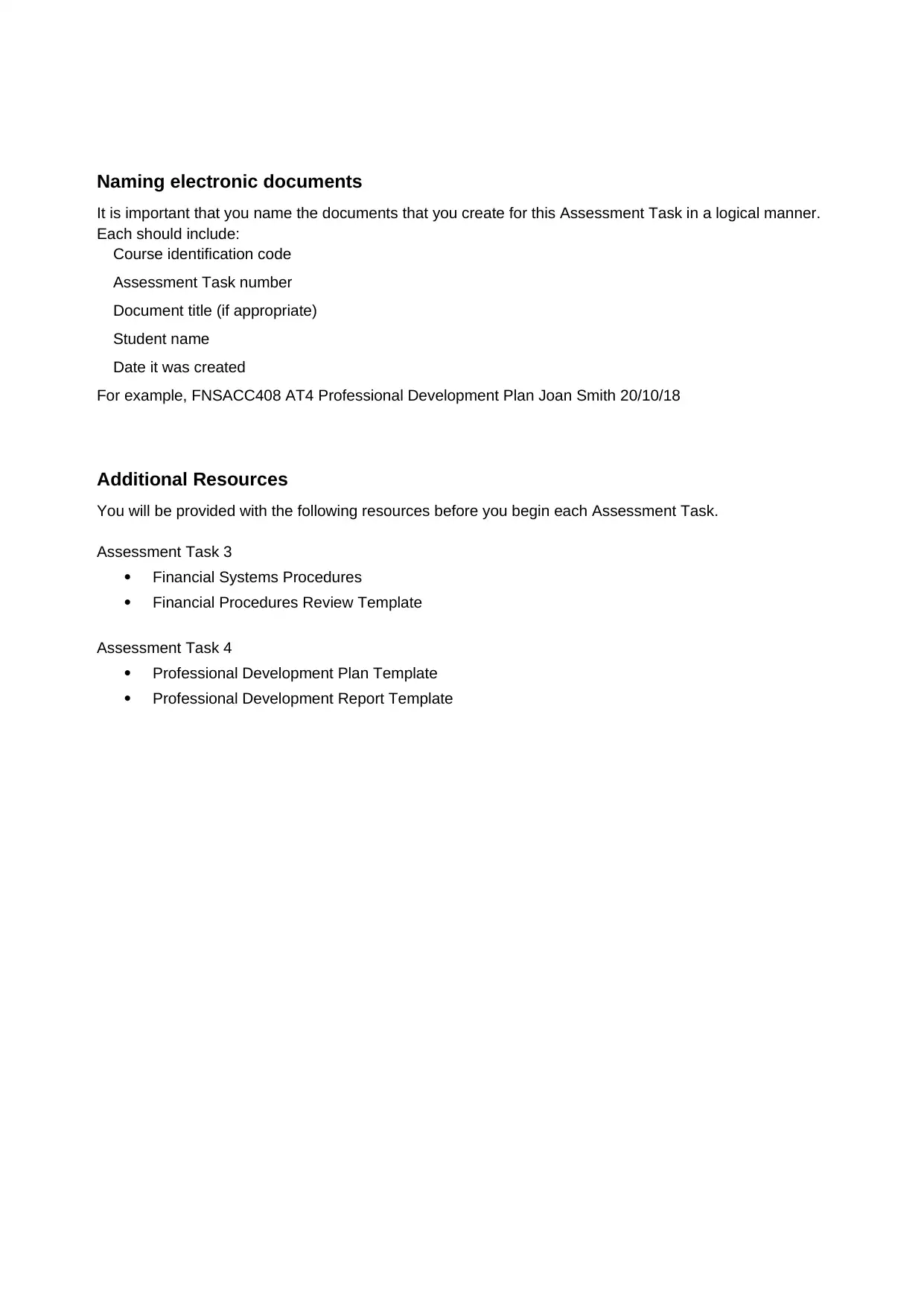
Naming electronic documents
It is important that you name the documents that you create for this Assessment Task in a logical manner.
Each should include:
Course identification code
Assessment Task number
Document title (if appropriate)
Student name
Date it was created
For example, FNSACC408 AT4 Professional Development Plan Joan Smith 20/10/18
Additional Resources
You will be provided with the following resources before you begin each Assessment Task.
Assessment Task 3
Financial Systems Procedures
Financial Procedures Review Template
Assessment Task 4
Professional Development Plan Template
Professional Development Report Template
It is important that you name the documents that you create for this Assessment Task in a logical manner.
Each should include:
Course identification code
Assessment Task number
Document title (if appropriate)
Student name
Date it was created
For example, FNSACC408 AT4 Professional Development Plan Joan Smith 20/10/18
Additional Resources
You will be provided with the following resources before you begin each Assessment Task.
Assessment Task 3
Financial Systems Procedures
Financial Procedures Review Template
Assessment Task 4
Professional Development Plan Template
Professional Development Report Template
Paraphrase This Document
Need a fresh take? Get an instant paraphrase of this document with our AI Paraphraser
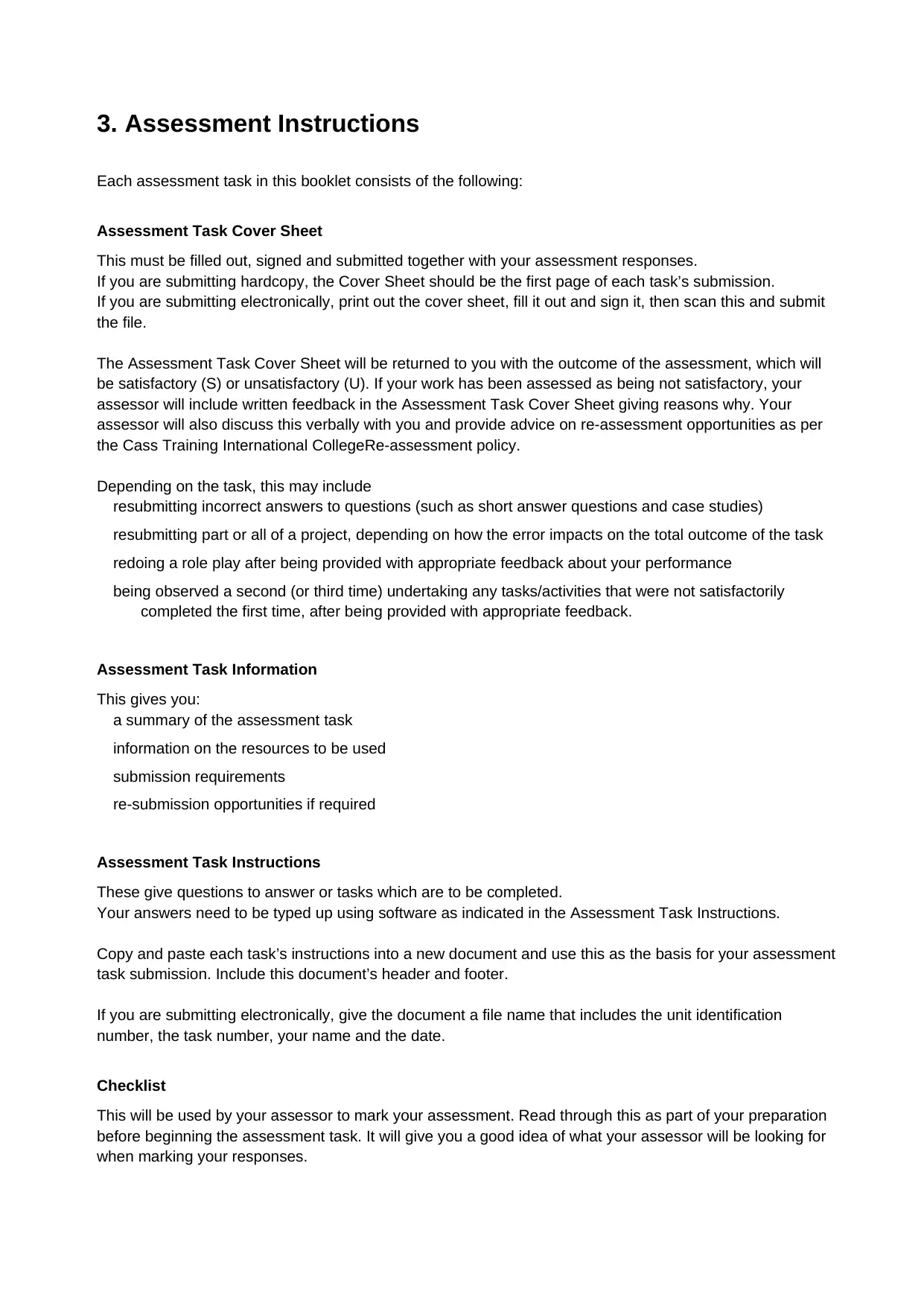
3. Assessment Instructions
Each assessment task in this booklet consists of the following:
Assessment Task Cover Sheet
This must be filled out, signed and submitted together with your assessment responses.
If you are submitting hardcopy, the Cover Sheet should be the first page of each task’s submission.
If you are submitting electronically, print out the cover sheet, fill it out and sign it, then scan this and submit
the file.
The Assessment Task Cover Sheet will be returned to you with the outcome of the assessment, which will
be satisfactory (S) or unsatisfactory (U). If your work has been assessed as being not satisfactory, your
assessor will include written feedback in the Assessment Task Cover Sheet giving reasons why. Your
assessor will also discuss this verbally with you and provide advice on re-assessment opportunities as per
the Cass Training International CollegeRe-assessment policy.
Depending on the task, this may include
resubmitting incorrect answers to questions (such as short answer questions and case studies)
resubmitting part or all of a project, depending on how the error impacts on the total outcome of the task
redoing a role play after being provided with appropriate feedback about your performance
being observed a second (or third time) undertaking any tasks/activities that were not satisfactorily
completed the first time, after being provided with appropriate feedback.
Assessment Task Information
This gives you:
a summary of the assessment task
information on the resources to be used
submission requirements
re-submission opportunities if required
Assessment Task Instructions
These give questions to answer or tasks which are to be completed.
Your answers need to be typed up using software as indicated in the Assessment Task Instructions.
Copy and paste each task’s instructions into a new document and use this as the basis for your assessment
task submission. Include this document’s header and footer.
If you are submitting electronically, give the document a file name that includes the unit identification
number, the task number, your name and the date.
Checklist
This will be used by your assessor to mark your assessment. Read through this as part of your preparation
before beginning the assessment task. It will give you a good idea of what your assessor will be looking for
when marking your responses.
Each assessment task in this booklet consists of the following:
Assessment Task Cover Sheet
This must be filled out, signed and submitted together with your assessment responses.
If you are submitting hardcopy, the Cover Sheet should be the first page of each task’s submission.
If you are submitting electronically, print out the cover sheet, fill it out and sign it, then scan this and submit
the file.
The Assessment Task Cover Sheet will be returned to you with the outcome of the assessment, which will
be satisfactory (S) or unsatisfactory (U). If your work has been assessed as being not satisfactory, your
assessor will include written feedback in the Assessment Task Cover Sheet giving reasons why. Your
assessor will also discuss this verbally with you and provide advice on re-assessment opportunities as per
the Cass Training International CollegeRe-assessment policy.
Depending on the task, this may include
resubmitting incorrect answers to questions (such as short answer questions and case studies)
resubmitting part or all of a project, depending on how the error impacts on the total outcome of the task
redoing a role play after being provided with appropriate feedback about your performance
being observed a second (or third time) undertaking any tasks/activities that were not satisfactorily
completed the first time, after being provided with appropriate feedback.
Assessment Task Information
This gives you:
a summary of the assessment task
information on the resources to be used
submission requirements
re-submission opportunities if required
Assessment Task Instructions
These give questions to answer or tasks which are to be completed.
Your answers need to be typed up using software as indicated in the Assessment Task Instructions.
Copy and paste each task’s instructions into a new document and use this as the basis for your assessment
task submission. Include this document’s header and footer.
If you are submitting electronically, give the document a file name that includes the unit identification
number, the task number, your name and the date.
Checklist
This will be used by your assessor to mark your assessment. Read through this as part of your preparation
before beginning the assessment task. It will give you a good idea of what your assessor will be looking for
when marking your responses.
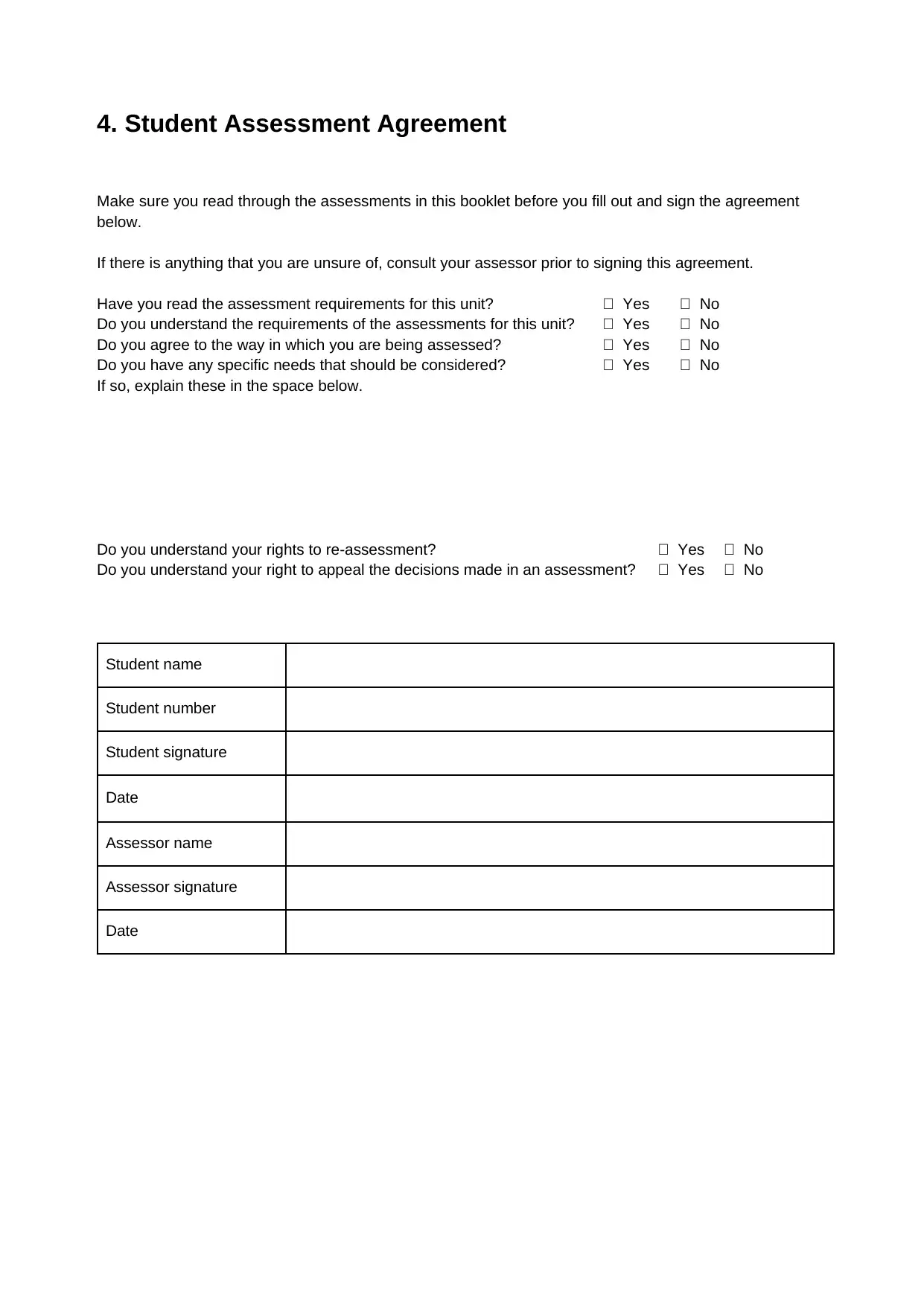
4. Student Assessment Agreement
Make sure you read through the assessments in this booklet before you fill out and sign the agreement
below.
If there is anything that you are unsure of, consult your assessor prior to signing this agreement.
Have you read the assessment requirements for this unit? Yes No
Do you understand the requirements of the assessments for this unit? Yes No
Do you agree to the way in which you are being assessed? Yes No
Do you have any specific needs that should be considered? Yes No
If so, explain these in the space below.
Do you understand your rights to re-assessment? Yes No
Do you understand your right to appeal the decisions made in an assessment? Yes No
Student name
Student number
Student signature
Date
Assessor name
Assessor signature
Date
Make sure you read through the assessments in this booklet before you fill out and sign the agreement
below.
If there is anything that you are unsure of, consult your assessor prior to signing this agreement.
Have you read the assessment requirements for this unit? Yes No
Do you understand the requirements of the assessments for this unit? Yes No
Do you agree to the way in which you are being assessed? Yes No
Do you have any specific needs that should be considered? Yes No
If so, explain these in the space below.
Do you understand your rights to re-assessment? Yes No
Do you understand your right to appeal the decisions made in an assessment? Yes No
Student name
Student number
Student signature
Date
Assessor name
Assessor signature
Date
⊘ This is a preview!⊘
Do you want full access?
Subscribe today to unlock all pages.

Trusted by 1+ million students worldwide
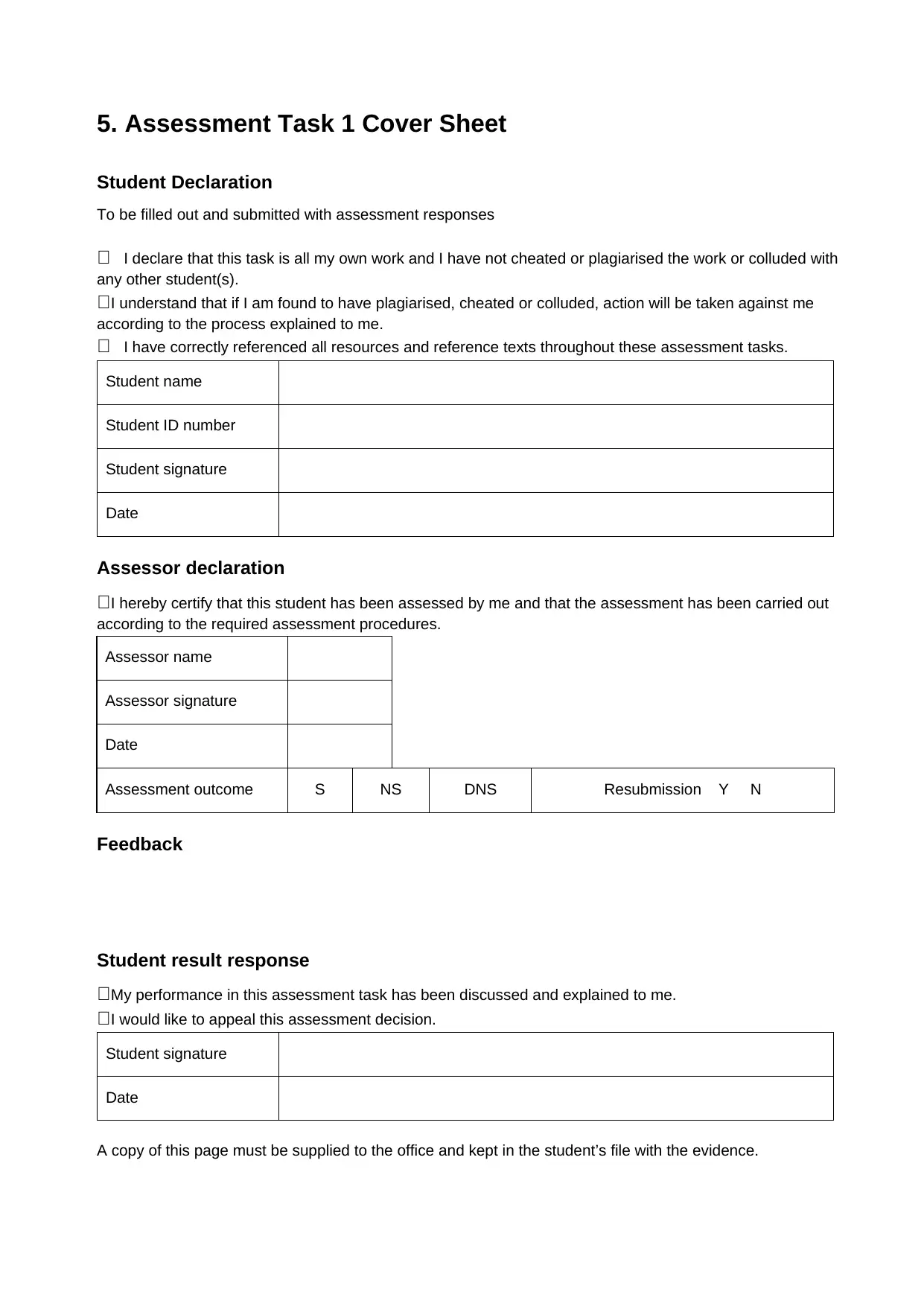
5. Assessment Task 1 Cover Sheet
Student Declaration
To be filled out and submitted with assessment responses
I declare that this task is all my own work and I have not cheated or plagiarised the work or colluded with
any other student(s).
I understand that if I am found to have plagiarised, cheated or colluded, action will be taken against me
according to the process explained to me.
I have correctly referenced all resources and reference texts throughout these assessment tasks.
Student name
Student ID number
Student signature
Date
Assessor declaration
I hereby certify that this student has been assessed by me and that the assessment has been carried out
according to the required assessment procedures.
Assessor name
Assessor signature
Date
Assessment outcome S NS DNS Resubmission Y N
Feedback
Student result response
My performance in this assessment task has been discussed and explained to me.
I would like to appeal this assessment decision.
Student signature
Date
A copy of this page must be supplied to the office and kept in the student’s file with the evidence.
Student Declaration
To be filled out and submitted with assessment responses
I declare that this task is all my own work and I have not cheated or plagiarised the work or colluded with
any other student(s).
I understand that if I am found to have plagiarised, cheated or colluded, action will be taken against me
according to the process explained to me.
I have correctly referenced all resources and reference texts throughout these assessment tasks.
Student name
Student ID number
Student signature
Date
Assessor declaration
I hereby certify that this student has been assessed by me and that the assessment has been carried out
according to the required assessment procedures.
Assessor name
Assessor signature
Date
Assessment outcome S NS DNS Resubmission Y N
Feedback
Student result response
My performance in this assessment task has been discussed and explained to me.
I would like to appeal this assessment decision.
Student signature
Date
A copy of this page must be supplied to the office and kept in the student’s file with the evidence.
Paraphrase This Document
Need a fresh take? Get an instant paraphrase of this document with our AI Paraphraser
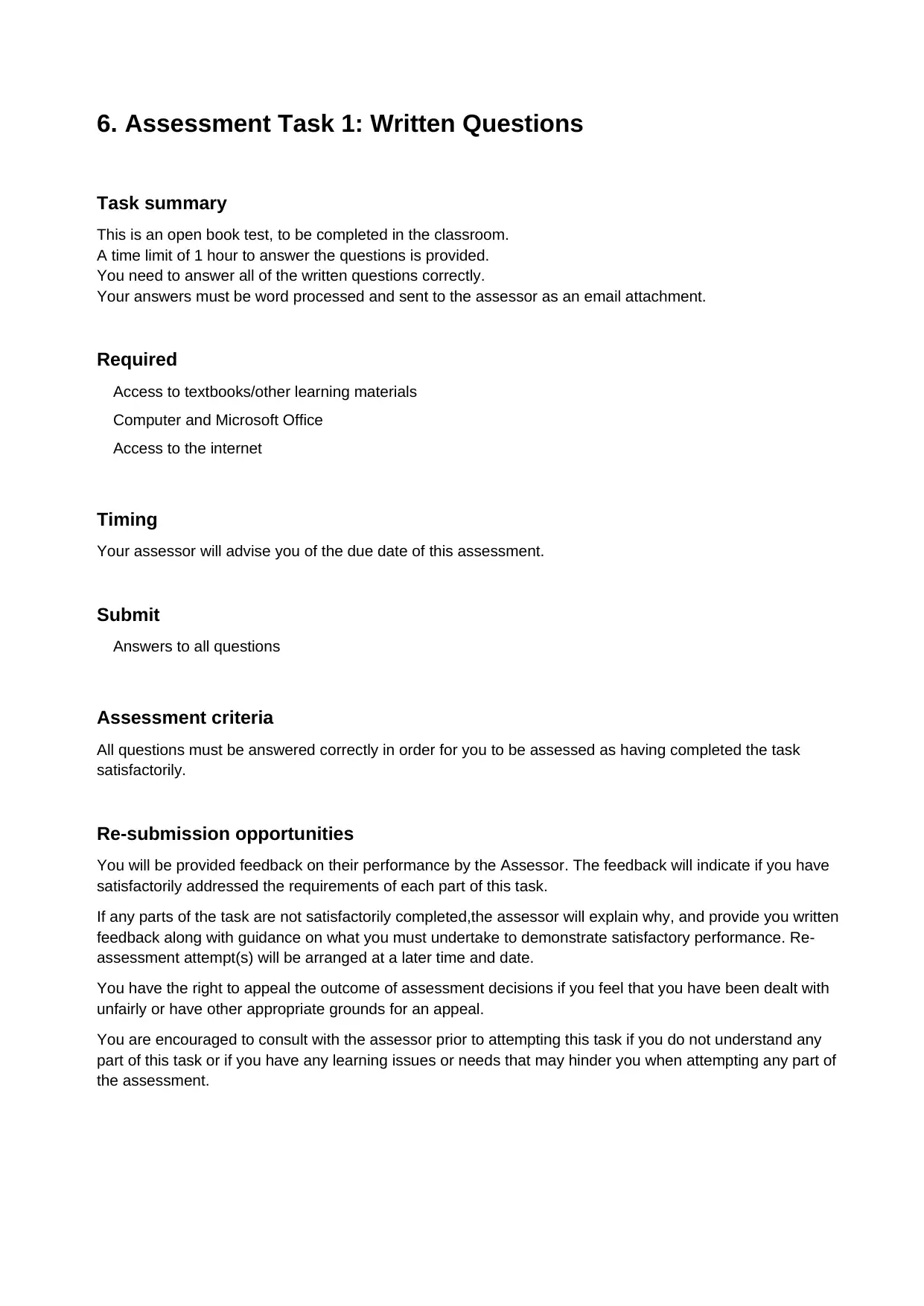
6. Assessment Task 1: Written Questions
Task summary
This is an open book test, to be completed in the classroom.
A time limit of 1 hour to answer the questions is provided.
You need to answer all of the written questions correctly.
Your answers must be word processed and sent to the assessor as an email attachment.
Required
Access to textbooks/other learning materials
Computer and Microsoft Office
Access to the internet
Timing
Your assessor will advise you of the due date of this assessment.
Submit
Answers to all questions
Assessment criteria
All questions must be answered correctly in order for you to be assessed as having completed the task
satisfactorily.
Re-submission opportunities
You will be provided feedback on their performance by the Assessor. The feedback will indicate if you have
satisfactorily addressed the requirements of each part of this task.
If any parts of the task are not satisfactorily completed,the assessor will explain why, and provide you written
feedback along with guidance on what you must undertake to demonstrate satisfactory performance. Re-
assessment attempt(s) will be arranged at a later time and date.
You have the right to appeal the outcome of assessment decisions if you feel that you have been dealt with
unfairly or have other appropriate grounds for an appeal.
You are encouraged to consult with the assessor prior to attempting this task if you do not understand any
part of this task or if you have any learning issues or needs that may hinder you when attempting any part of
the assessment.
Task summary
This is an open book test, to be completed in the classroom.
A time limit of 1 hour to answer the questions is provided.
You need to answer all of the written questions correctly.
Your answers must be word processed and sent to the assessor as an email attachment.
Required
Access to textbooks/other learning materials
Computer and Microsoft Office
Access to the internet
Timing
Your assessor will advise you of the due date of this assessment.
Submit
Answers to all questions
Assessment criteria
All questions must be answered correctly in order for you to be assessed as having completed the task
satisfactorily.
Re-submission opportunities
You will be provided feedback on their performance by the Assessor. The feedback will indicate if you have
satisfactorily addressed the requirements of each part of this task.
If any parts of the task are not satisfactorily completed,the assessor will explain why, and provide you written
feedback along with guidance on what you must undertake to demonstrate satisfactory performance. Re-
assessment attempt(s) will be arranged at a later time and date.
You have the right to appeal the outcome of assessment decisions if you feel that you have been dealt with
unfairly or have other appropriate grounds for an appeal.
You are encouraged to consult with the assessor prior to attempting this task if you do not understand any
part of this task or if you have any learning issues or needs that may hinder you when attempting any part of
the assessment.
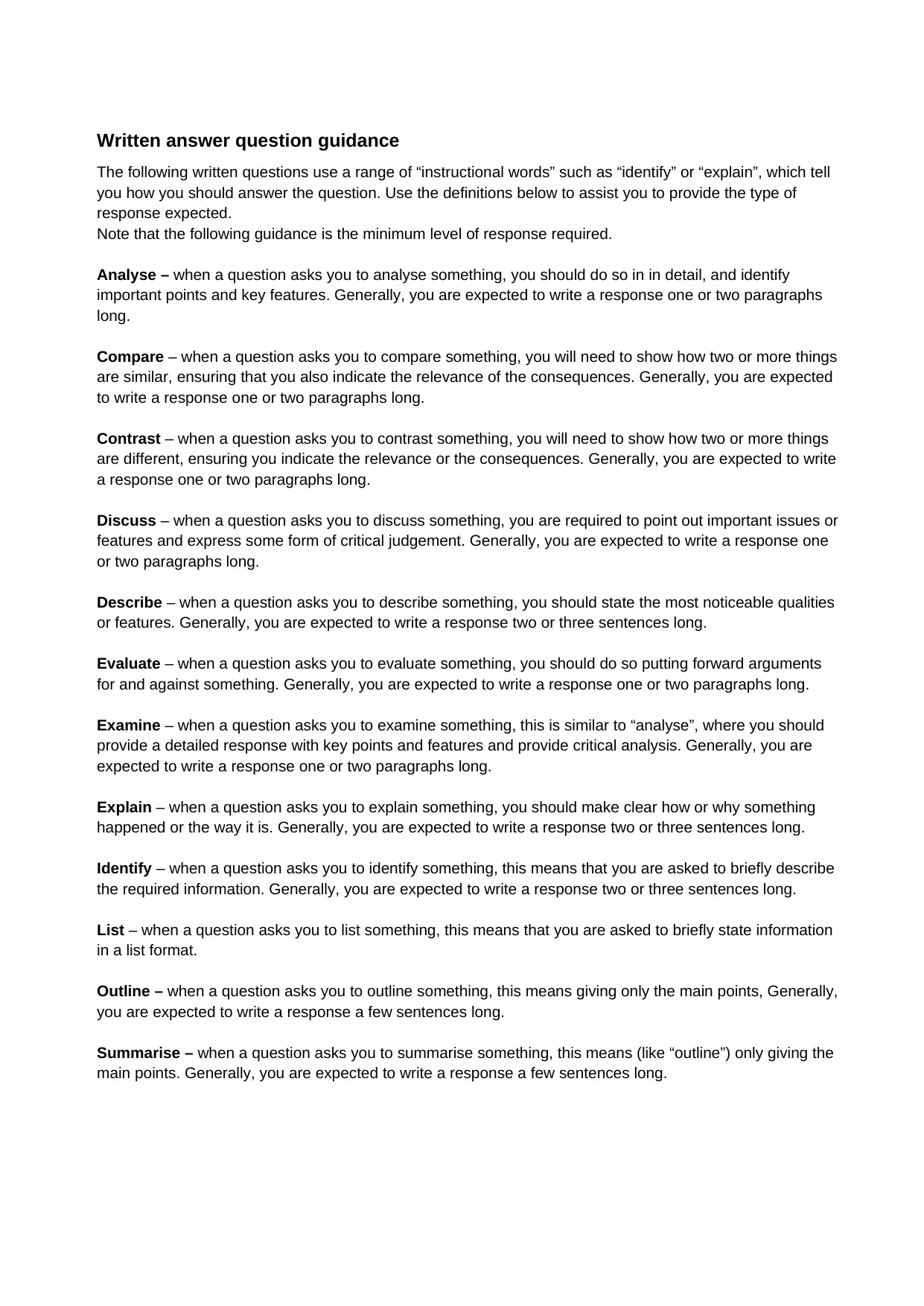
Written answer question guidance
The following written questions use a range of “instructional words” such as “identify” or “explain”, which tell
you how you should answer the question. Use the definitions below to assist you to provide the type of
response expected.
Note that the following guidance is the minimum level of response required.
Analyse – when a question asks you to analyse something, you should do so in in detail, and identify
important points and key features. Generally, you are expected to write a response one or two paragraphs
long.
Compare – when a question asks you to compare something, you will need to show how two or more things
are similar, ensuring that you also indicate the relevance of the consequences. Generally, you are expected
to write a response one or two paragraphs long.
Contrast – when a question asks you to contrast something, you will need to show how two or more things
are different, ensuring you indicate the relevance or the consequences. Generally, you are expected to write
a response one or two paragraphs long.
Discuss – when a question asks you to discuss something, you are required to point out important issues or
features and express some form of critical judgement. Generally, you are expected to write a response one
or two paragraphs long.
Describe – when a question asks you to describe something, you should state the most noticeable qualities
or features. Generally, you are expected to write a response two or three sentences long.
Evaluate – when a question asks you to evaluate something, you should do so putting forward arguments
for and against something. Generally, you are expected to write a response one or two paragraphs long.
Examine – when a question asks you to examine something, this is similar to “analyse”, where you should
provide a detailed response with key points and features and provide critical analysis. Generally, you are
expected to write a response one or two paragraphs long.
Explain – when a question asks you to explain something, you should make clear how or why something
happened or the way it is. Generally, you are expected to write a response two or three sentences long.
Identify – when a question asks you to identify something, this means that you are asked to briefly describe
the required information. Generally, you are expected to write a response two or three sentences long.
List – when a question asks you to list something, this means that you are asked to briefly state information
in a list format.
Outline – when a question asks you to outline something, this means giving only the main points, Generally,
you are expected to write a response a few sentences long.
Summarise – when a question asks you to summarise something, this means (like “outline”) only giving the
main points. Generally, you are expected to write a response a few sentences long.
The following written questions use a range of “instructional words” such as “identify” or “explain”, which tell
you how you should answer the question. Use the definitions below to assist you to provide the type of
response expected.
Note that the following guidance is the minimum level of response required.
Analyse – when a question asks you to analyse something, you should do so in in detail, and identify
important points and key features. Generally, you are expected to write a response one or two paragraphs
long.
Compare – when a question asks you to compare something, you will need to show how two or more things
are similar, ensuring that you also indicate the relevance of the consequences. Generally, you are expected
to write a response one or two paragraphs long.
Contrast – when a question asks you to contrast something, you will need to show how two or more things
are different, ensuring you indicate the relevance or the consequences. Generally, you are expected to write
a response one or two paragraphs long.
Discuss – when a question asks you to discuss something, you are required to point out important issues or
features and express some form of critical judgement. Generally, you are expected to write a response one
or two paragraphs long.
Describe – when a question asks you to describe something, you should state the most noticeable qualities
or features. Generally, you are expected to write a response two or three sentences long.
Evaluate – when a question asks you to evaluate something, you should do so putting forward arguments
for and against something. Generally, you are expected to write a response one or two paragraphs long.
Examine – when a question asks you to examine something, this is similar to “analyse”, where you should
provide a detailed response with key points and features and provide critical analysis. Generally, you are
expected to write a response one or two paragraphs long.
Explain – when a question asks you to explain something, you should make clear how or why something
happened or the way it is. Generally, you are expected to write a response two or three sentences long.
Identify – when a question asks you to identify something, this means that you are asked to briefly describe
the required information. Generally, you are expected to write a response two or three sentences long.
List – when a question asks you to list something, this means that you are asked to briefly state information
in a list format.
Outline – when a question asks you to outline something, this means giving only the main points, Generally,
you are expected to write a response a few sentences long.
Summarise – when a question asks you to summarise something, this means (like “outline”) only giving the
main points. Generally, you are expected to write a response a few sentences long.
⊘ This is a preview!⊘
Do you want full access?
Subscribe today to unlock all pages.

Trusted by 1+ million students worldwide
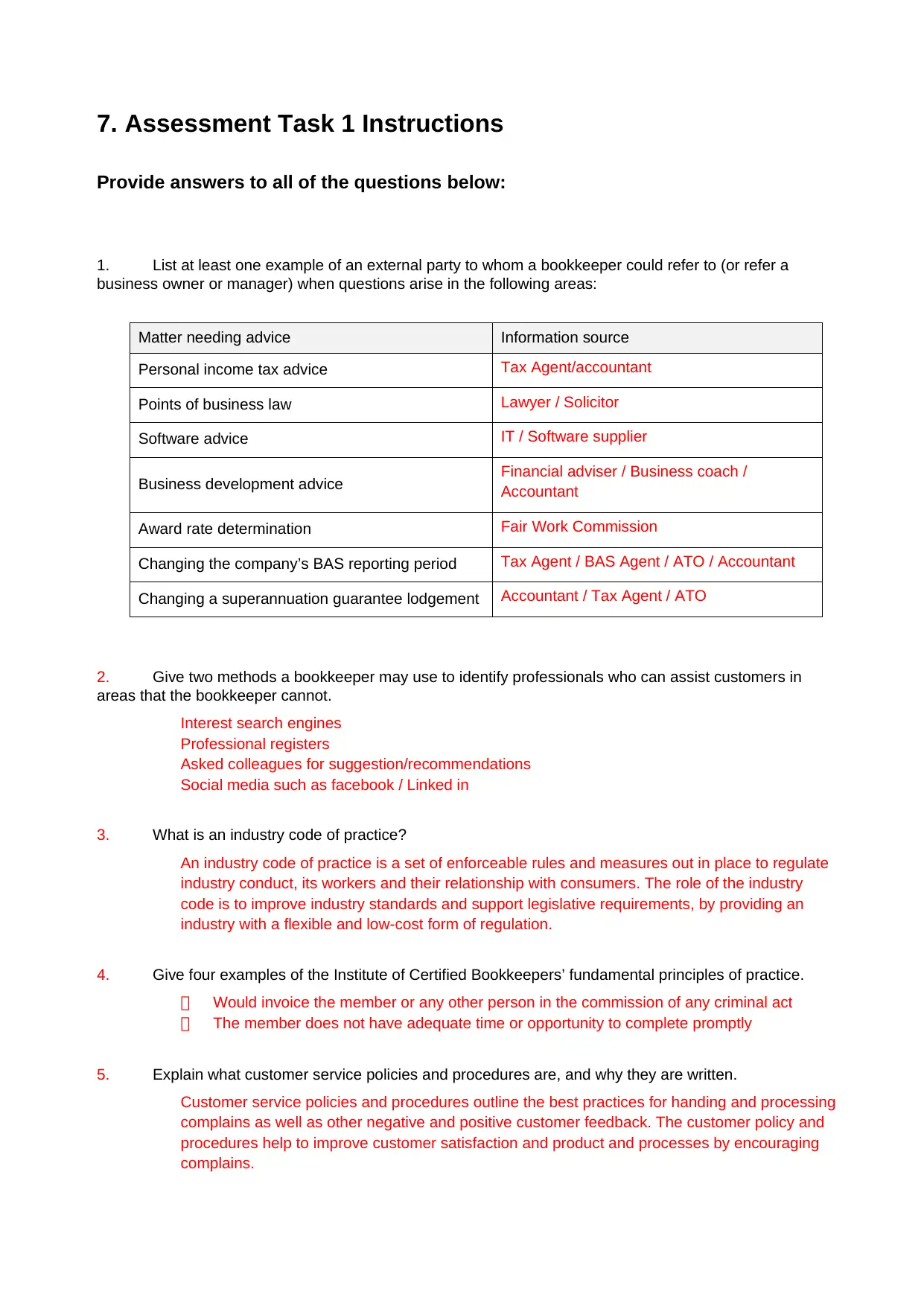
7. Assessment Task 1 Instructions
Provide answers to all of the questions below:
1. List at least one example of an external party to whom a bookkeeper could refer to (or refer a
business owner or manager) when questions arise in the following areas:
Matter needing advice Information source
Personal income tax advice Tax Agent/accountant
Points of business law Lawyer / Solicitor
Software advice IT / Software supplier
Business development advice Financial adviser / Business coach /
Accountant
Award rate determination Fair Work Commission
Changing the company’s BAS reporting period Tax Agent / BAS Agent / ATO / Accountant
Changing a superannuation guarantee lodgement Accountant / Tax Agent / ATO
2. Give two methods a bookkeeper may use to identify professionals who can assist customers in
areas that the bookkeeper cannot.
Interest search engines
Professional registers
Asked colleagues for suggestion/recommendations
Social media such as facebook / Linked in
3. What is an industry code of practice?
An industry code of practice is a set of enforceable rules and measures out in place to regulate
industry conduct, its workers and their relationship with consumers. The role of the industry
code is to improve industry standards and support legislative requirements, by providing an
industry with a flexible and low-cost form of regulation.
4. Give four examples of the Institute of Certified Bookkeepers’ fundamental principles of practice.
Would invoice the member or any other person in the commission of any criminal act
The member does not have adequate time or opportunity to complete promptly
5. Explain what customer service policies and procedures are, and why they are written.
Customer service policies and procedures outline the best practices for handing and processing
complains as well as other negative and positive customer feedback. The customer policy and
procedures help to improve customer satisfaction and product and processes by encouraging
complains.
Provide answers to all of the questions below:
1. List at least one example of an external party to whom a bookkeeper could refer to (or refer a
business owner or manager) when questions arise in the following areas:
Matter needing advice Information source
Personal income tax advice Tax Agent/accountant
Points of business law Lawyer / Solicitor
Software advice IT / Software supplier
Business development advice Financial adviser / Business coach /
Accountant
Award rate determination Fair Work Commission
Changing the company’s BAS reporting period Tax Agent / BAS Agent / ATO / Accountant
Changing a superannuation guarantee lodgement Accountant / Tax Agent / ATO
2. Give two methods a bookkeeper may use to identify professionals who can assist customers in
areas that the bookkeeper cannot.
Interest search engines
Professional registers
Asked colleagues for suggestion/recommendations
Social media such as facebook / Linked in
3. What is an industry code of practice?
An industry code of practice is a set of enforceable rules and measures out in place to regulate
industry conduct, its workers and their relationship with consumers. The role of the industry
code is to improve industry standards and support legislative requirements, by providing an
industry with a flexible and low-cost form of regulation.
4. Give four examples of the Institute of Certified Bookkeepers’ fundamental principles of practice.
Would invoice the member or any other person in the commission of any criminal act
The member does not have adequate time or opportunity to complete promptly
5. Explain what customer service policies and procedures are, and why they are written.
Customer service policies and procedures outline the best practices for handing and processing
complains as well as other negative and positive customer feedback. The customer policy and
procedures help to improve customer satisfaction and product and processes by encouraging
complains.
Paraphrase This Document
Need a fresh take? Get an instant paraphrase of this document with our AI Paraphraser
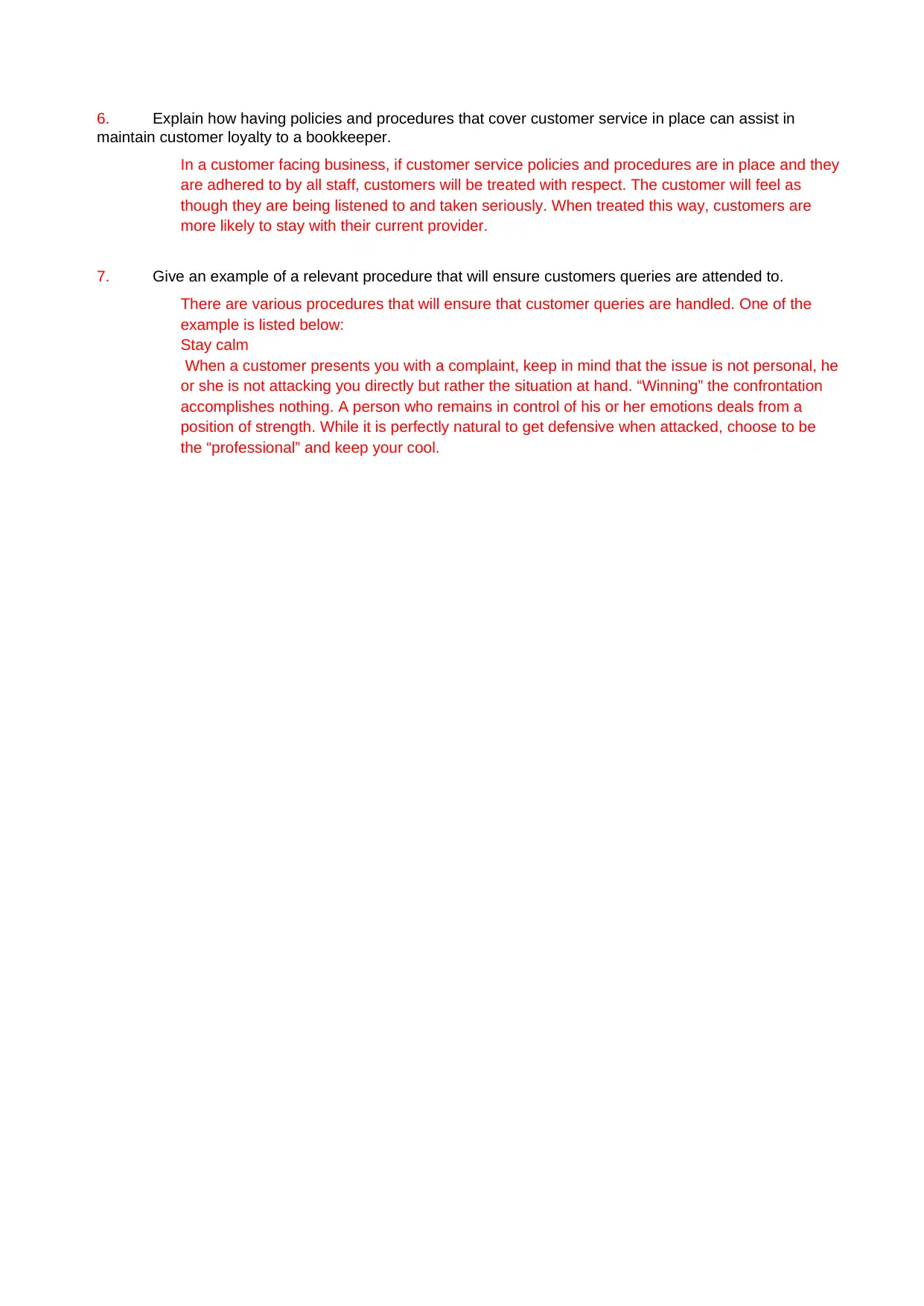
6. Explain how having policies and procedures that cover customer service in place can assist in
maintain customer loyalty to a bookkeeper.
In a customer facing business, if customer service policies and procedures are in place and they
are adhered to by all staff, customers will be treated with respect. The customer will feel as
though they are being listened to and taken seriously. When treated this way, customers are
more likely to stay with their current provider.
7. Give an example of a relevant procedure that will ensure customers queries are attended to.
There are various procedures that will ensure that customer queries are handled. One of the
example is listed below:
Stay calm
When a customer presents you with a complaint, keep in mind that the issue is not personal, he
or she is not attacking you directly but rather the situation at hand. “Winning” the confrontation
accomplishes nothing. A person who remains in control of his or her emotions deals from a
position of strength. While it is perfectly natural to get defensive when attacked, choose to be
the “professional” and keep your cool.
maintain customer loyalty to a bookkeeper.
In a customer facing business, if customer service policies and procedures are in place and they
are adhered to by all staff, customers will be treated with respect. The customer will feel as
though they are being listened to and taken seriously. When treated this way, customers are
more likely to stay with their current provider.
7. Give an example of a relevant procedure that will ensure customers queries are attended to.
There are various procedures that will ensure that customer queries are handled. One of the
example is listed below:
Stay calm
When a customer presents you with a complaint, keep in mind that the issue is not personal, he
or she is not attacking you directly but rather the situation at hand. “Winning” the confrontation
accomplishes nothing. A person who remains in control of his or her emotions deals from a
position of strength. While it is perfectly natural to get defensive when attacked, choose to be
the “professional” and keep your cool.
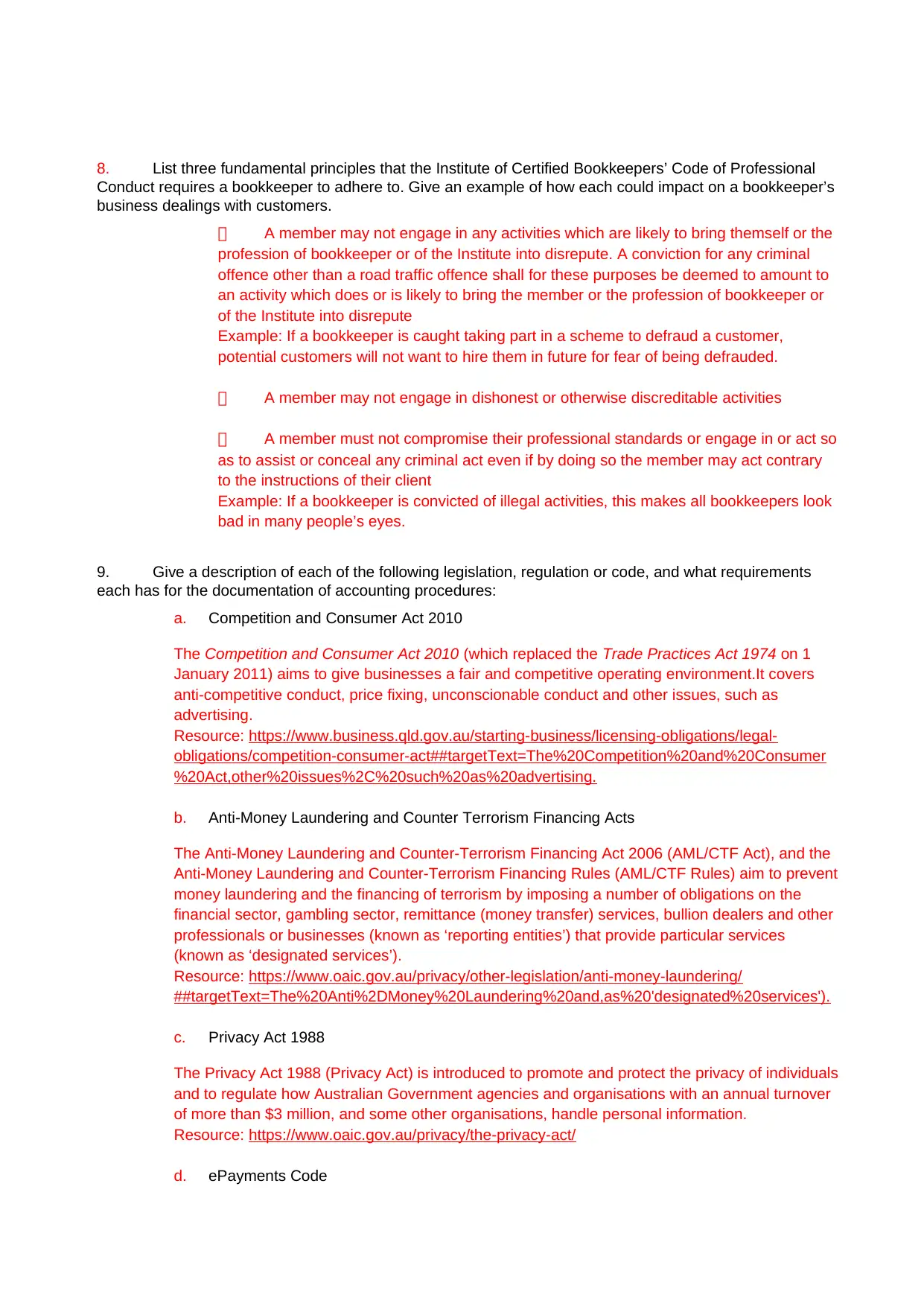
8. List three fundamental principles that the Institute of Certified Bookkeepers’ Code of Professional
Conduct requires a bookkeeper to adhere to. Give an example of how each could impact on a bookkeeper’s
business dealings with customers.
A member may not engage in any activities which are likely to bring themself or the
profession of bookkeeper or of the Institute into disrepute. A conviction for any criminal
offence other than a road traffic offence shall for these purposes be deemed to amount to
an activity which does or is likely to bring the member or the profession of bookkeeper or
of the Institute into disrepute
Example: If a bookkeeper is caught taking part in a scheme to defraud a customer,
potential customers will not want to hire them in future for fear of being defrauded.
A member may not engage in dishonest or otherwise discreditable activities
A member must not compromise their professional standards or engage in or act so
as to assist or conceal any criminal act even if by doing so the member may act contrary
to the instructions of their client
Example: If a bookkeeper is convicted of illegal activities, this makes all bookkeepers look
bad in many people’s eyes.
9. Give a description of each of the following legislation, regulation or code, and what requirements
each has for the documentation of accounting procedures:
a. Competition and Consumer Act 2010
The Competition and Consumer Act 2010 (which replaced the Trade Practices Act 1974 on 1
January 2011) aims to give businesses a fair and competitive operating environment.It covers
anti-competitive conduct, price fixing, unconscionable conduct and other issues, such as
advertising.
Resource: https://www.business.qld.gov.au/starting-business/licensing-obligations/legal-
obligations/competition-consumer-act##targetText=The%20Competition%20and%20Consumer
%20Act,other%20issues%2C%20such%20as%20advertising.
b. Anti-Money Laundering and Counter Terrorism Financing Acts
The Anti-Money Laundering and Counter-Terrorism Financing Act 2006 (AML/CTF Act), and the
Anti-Money Laundering and Counter-Terrorism Financing Rules (AML/CTF Rules) aim to prevent
money laundering and the financing of terrorism by imposing a number of obligations on the
financial sector, gambling sector, remittance (money transfer) services, bullion dealers and other
professionals or businesses (known as ‘reporting entities’) that provide particular services
(known as ‘designated services’).
Resource: https://www.oaic.gov.au/privacy/other-legislation/anti-money-laundering/
##targetText=The%20Anti%2DMoney%20Laundering%20and,as%20'designated%20services').
c. Privacy Act 1988
The Privacy Act 1988 (Privacy Act) is introduced to promote and protect the privacy of individuals
and to regulate how Australian Government agencies and organisations with an annual turnover
of more than $3 million, and some other organisations, handle personal information.
Resource: https://www.oaic.gov.au/privacy/the-privacy-act/
d. ePayments Code
Conduct requires a bookkeeper to adhere to. Give an example of how each could impact on a bookkeeper’s
business dealings with customers.
A member may not engage in any activities which are likely to bring themself or the
profession of bookkeeper or of the Institute into disrepute. A conviction for any criminal
offence other than a road traffic offence shall for these purposes be deemed to amount to
an activity which does or is likely to bring the member or the profession of bookkeeper or
of the Institute into disrepute
Example: If a bookkeeper is caught taking part in a scheme to defraud a customer,
potential customers will not want to hire them in future for fear of being defrauded.
A member may not engage in dishonest or otherwise discreditable activities
A member must not compromise their professional standards or engage in or act so
as to assist or conceal any criminal act even if by doing so the member may act contrary
to the instructions of their client
Example: If a bookkeeper is convicted of illegal activities, this makes all bookkeepers look
bad in many people’s eyes.
9. Give a description of each of the following legislation, regulation or code, and what requirements
each has for the documentation of accounting procedures:
a. Competition and Consumer Act 2010
The Competition and Consumer Act 2010 (which replaced the Trade Practices Act 1974 on 1
January 2011) aims to give businesses a fair and competitive operating environment.It covers
anti-competitive conduct, price fixing, unconscionable conduct and other issues, such as
advertising.
Resource: https://www.business.qld.gov.au/starting-business/licensing-obligations/legal-
obligations/competition-consumer-act##targetText=The%20Competition%20and%20Consumer
%20Act,other%20issues%2C%20such%20as%20advertising.
b. Anti-Money Laundering and Counter Terrorism Financing Acts
The Anti-Money Laundering and Counter-Terrorism Financing Act 2006 (AML/CTF Act), and the
Anti-Money Laundering and Counter-Terrorism Financing Rules (AML/CTF Rules) aim to prevent
money laundering and the financing of terrorism by imposing a number of obligations on the
financial sector, gambling sector, remittance (money transfer) services, bullion dealers and other
professionals or businesses (known as ‘reporting entities’) that provide particular services
(known as ‘designated services’).
Resource: https://www.oaic.gov.au/privacy/other-legislation/anti-money-laundering/
##targetText=The%20Anti%2DMoney%20Laundering%20and,as%20'designated%20services').
c. Privacy Act 1988
The Privacy Act 1988 (Privacy Act) is introduced to promote and protect the privacy of individuals
and to regulate how Australian Government agencies and organisations with an annual turnover
of more than $3 million, and some other organisations, handle personal information.
Resource: https://www.oaic.gov.au/privacy/the-privacy-act/
d. ePayments Code
⊘ This is a preview!⊘
Do you want full access?
Subscribe today to unlock all pages.

Trusted by 1+ million students worldwide
1 out of 41
Related Documents
Your All-in-One AI-Powered Toolkit for Academic Success.
+13062052269
info@desklib.com
Available 24*7 on WhatsApp / Email
![[object Object]](/_next/static/media/star-bottom.7253800d.svg)
Unlock your academic potential
Copyright © 2020–2025 A2Z Services. All Rights Reserved. Developed and managed by ZUCOL.





